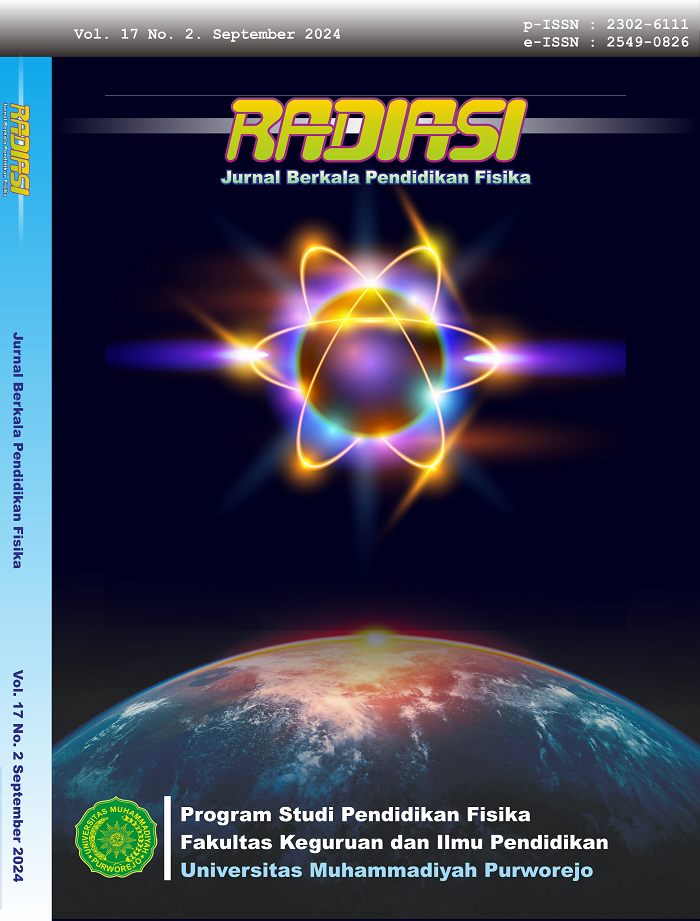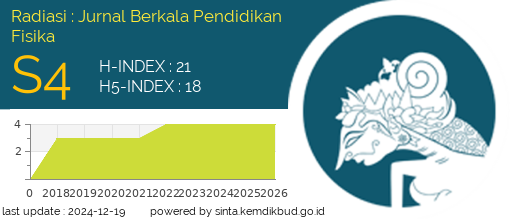Graphical Analyzer Test of Misconception of 45o Angle as Optimal Angle in Projectile Motion
Abstract
Misconceptions still often occur when learning physics, especially in conducting research that is not consistently detailed in identifying an observation. In parabolic motion material, it is known that 45° is a special angle that produces the farthest distance. The misconception that 45° is the angle that produces the farthest distance has become a reference in learning in various educational institutions to date. The aim of this research is to identify and prove that the 45° angle is not an elevation angle that produces the farthest distance in a vacuum that ignores the initial position of the thrower. This research was conducted using PhET virtual laboratory media which was analyzed based on quantitative and qualitative methods. This study will test the elevation angle of 42° : 45° : 48° based on altitude 0 m : 1 m : 2 m. After the observational data has been obtained and proven by the existing equations, the research results will be analyzed based on the functional analyzer approach by making the equations into function graphs to make it easier for readers to read the existing data. In this study, it was found that the angle of 42° is the producer of the farthest distance and also gets a relatively faster travel time compared to the angle of 45° which we know so far as a special angle that produces the farthest distance in non-vacuum conditions.
Downloads
References
L. Nanjanee, H. I. Zulfa, and A. Alkomah, “Percobaan Gerak Parabola Dengan Papan Seluncur,” SPEKTRA J. Kaji. Pendidik. Sains, vol. 3, no. 2, p. 187, 2017, doi: 10.32699/spektra.v3i2.37.
A. E. Kossovsky, The birth of a science, vol. 2, no. 5316. 1962. doi: 10.1136/bmj.2.5316.1380.
B. R. H. Naylor, “Galileo’s Theory of Projectile Motion,” Isis, vol. 71, no. 4, pp. 550–570, 1980, doi: 10.1086/352592.
S. Drake and J. MacLachlan, “Galileo’s Discovery of the Parabolic Trajectory,” Sci. Am., vol. 232, no. 3, pp. 102–111, Jan. 1975.
J. Rajagukguk and C. Sarumaha, “Pemodelan Dan Analisis Gerak Parabola Dua Dimensi Dengan Menggunakan Aplikasi Gui Matlab,” J. Saintika, vol. 17, pp. 63–68, 2017.
A. R. Aththibby, “Pengembangan Media Pembelajaran Fisika Berbasis Animasi Flash Topik Bahasan Usaha Dan Energi,” J. Pendidik. Fis., vol. 3, no. 2, 2015, doi: 10.24127/jpf.v3i2.238.
M. Wakai and N. P. Linthorne, “Optimum take-off angle in the standing long jump,” Hum. Mov. Sci., vol. 24, no. 1, pp. 81–96, 2005, doi: 10.1016/j.humov.2004.12.001.
Z. Hidayatullah, J. N. Nadhiroh, E. Kartika, A. A. Nuha, and S. Y. Erlangga, “Identifikasi Miskonsepsi Dan Konflik Kognitif Fisika: Kasus Terkait Perubahan KonseptuaL,” EDUSAINS, vol. 12, no. 1, pp. 64–71, 2020.
R. H. Pangihutan et al., “Pengaruh Besar Sudut terhadap Jarak Lemparan pada Gerak Parabola,” no. 16013006, pp. 1–4.
J. A. F. Castro and M. P. E. Morales, “‘Yin’ in a guided inquiry biology classroom - Exploring student challenges and difficulties,” J. Turk. Sci. Educ., vol. 14, no. 4, pp. 48–65, 2017, doi: 10.12973/tused.10212a.
C. H. Belgacem, “ Analysis of projectile motion with quadratic air resistance from a nonzero height using the Lambert W function ,” J. Taibah Univ. Sci., vol. 11, no. 2, pp. 328–331, 2017, doi: 10.1016/j.jtusci.2016.02.009.
A. O. Contreras, J. Juan Rosales García, L. M. Jiménez, and J. M. Cruz-Duarte, “Analysis of projectile motion in view of conformable derivative,” Open Phys., vol. 16, no. 1, pp. 581–587, 2018, doi: 10.1515/phys-2018-0076.
A. Kuhlow, “Die Technik des Kugelstoßens der Männer bei den Olympischen Spielen 1972 in München,” 1975, Limpert, Frankfurt/Main.
P. C. Li, “The impact statistical analysis of the shot throwing speed and angle on results based on numerical simulation,” vol. 8, pp. 198–203, Jan. 2013.
D. Hammer, “More than misconceptions: Multiple perspectives on student knowledge and reasoning, and an appropriate role for education research,” Am. J. Phys., vol. 64, no. 10, pp. 1316–1325, 1996, doi: 10.1119/1.18376.
N. Suprapto, “Do We Experience Misconceptions?: An Ontological Review of Misconceptions in Science,” Stud. Philos. Sci. Educ., vol. 1, no. 2, pp. 50–55, 2020, doi: 10.46627/sipose.v1i2.24.
T. S. Tuhusula et al., “Eksperimen Menggunakan Virtual Lab Berbasis Phet Simulation Dalam Pembelajaran Fisika Pada Materi Gerak Parabola Program Studi Pendidikan Fisika , Universitas Cenderawasih Learning Physics On Parabolic Movement Materials,” no. 2, 2020.
D. N. Sudjito, “Penggunaan modul praktikum mandiri berbasis simulasi phet dalam pembelajaran fisika tentang gerak parabola pada bidang datar,” Pros. Semin. Nas. MIPA, p. 16, 2019.
S. I. Milatti and H. Fitrihidajati, “Pengembangan Lembar Kegiatan Peserta Didik Elektronik (E-Lkpd) Berbasis Problem Based Learning Pada Materi Perubahan Lingkungan Untuk Melatihkan Kemampuan Berpikir Kritis,” vol. 13, no. 1, 2024.
E. Yulianti, N. N. Zhafirah, and N. Hidayat, “Exploring Guided Inquiry Learning with PhET Simulation to Train Junior High School Students Think Critically,” Berk. Ilm. Pendidik. Fis., vol. 9, no. 1, p. 96, Mar. 2021, doi: 10.20527/bipf.v9i1.9617.
C. L. Harum, M. Syukri, Y. Yusrizal, and C. Nurmaliah, “Pengaruh Model Pembelajaran Generatif Berbasis PhET Terhadap Keterampilan Berpikir Kritis dan Motivasi Belajar Siswa pada Materi Gelombang,” J. Pendidik. Sains Indones., vol. 8, no. 2, pp. 164–174, Oct. 2020, doi: 10.24815/jpsi.v8i2.15776.
I. R. Nugroho and B. Ruwanto, “Pengembangan Media Pembelajaran Fisika Berbasis Media Sosial Instagram Sebagai Sumber Belajar Mandiri Untuk Meningkatkan Motivasi dan Prestasi Belajar Fisika Siswa Kelas XI SMA”.
D. Misbahudin, C. Rochman, D. Nasrudin, and I. Solihati, “Penggunaan Power Point Sebagai Media Pembelajaran: Efektifkah?,” WaPFi Wahana Pendidik. Fis., vol. 3, no. 1, p. 43, Feb. 2018, doi: 10.17509/wapfi.v3i1.10939.
M. Davies and R. Barnett, Eds., The Palgrave Handbook of Critical Thinking in Higher Education. New York: Palgrave Macmillan US, 2015. doi: 10.1057/9781137378057.
W. Khumairok, A. Y. R. Wulandari, N. Qomaria, and L. K. Muharrami, “Profil Keterampilan Berpikir Kritis Siswa Smp Pada Materi Getaran Gelombang Dan Bunyi Menggunakan Soal Berbantuan Prompting Question,” Nat. Sci. Educ. Res., vol. 4, no. 1, pp. 35–44, Jul. 2021, doi: 10.21107/nser.v4i1.8353.
N. W. S. Darmayanti and L. S. Utami, “Penerapan Metode Latsol (Latihan Soal) Materi Pelajaran Fisika Melalui Kegiatan Bimbingan Belajar Di Luar Jam Sekolah Untuk Mengatasi Kesulitan Belajar Fisika Siswa Smp Di Desa Gontoran, Kecamatan Lingsar, Lombok BaraT,” SELAPARANG J. Pengabdi. Masy. Berkemajuan, vol. 2, no. 1, p. 35, Nov. 2018, doi: 10.31764/jpmb.v2i1.562.
A. J. Patandean, N. Natalia, and A. Swandi, “Analisis Kesulitan Belajar Fisika Siswa SMK di Halmahera Barat,” J. Ilm. Ecosyst., vol. 23, no. 2, pp. 317–325, Aug. 2023, doi: 10.35965/eco.v23i2.2856.
Copyright (c) 2024 Riki Purnama, Shidiq Andhika, Annisa Fitriani Nurul, Yunissa Cesariyanti, Rena Denya Agustina

This work is licensed under a Creative Commons Attribution-NonCommercial 4.0 International License.




